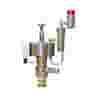With a Pneumatic Actuated Packed Plunger Pump driven by a larger piston driven by air attached to the packed plunger, (the plunger is used to displace the chemical) this actually amplifies the discharge pressure many times over the supply pressure used to drive the piston plunger while overcoming the pressure allowing the chemical to be injected. This design principle allows a pneumatic plunger pump to inject into a high pressure discharge with a relatively low supply pressure.
Neat chemicals or concentrated chemicals are ideal due to the fact that this type of pump can inject very small volumes over a variety of injection rates which makes it ideally suited to inject these small volumes. This eliminates having to resort to diluting the chemical with water and other compatible media just to be able to operate the pump at minimum rates without stalling the pump.
What should be considered when choosing a plunger pump?
Low volumes (1-2 liters a day are possible), high pressures (up to 13,100 psig), and high turndown (100 liters/hour down to 1-2 liters per hour) are some factors that should be considered when choosing this type of pump. Because of its unique design, a plunger pump has the ability to pump a wide variety of volumes and be reduced to only a few strokes per minute. Due to this fact it is ideally suited to pump neat (concentrated) chemicals while maintaining accuracy and repeatability in a wide range of environments and applications. We recommend that these types of pumps be connected to tanks located higher than the pump suction even when the tank is at its lowest level. This is called a “positive suction condition” and ensures that chemical is always available to be pumped. The other type of suction condition is called “suction lift” in which the pump has to draw chemical up from a tank which is below the pump suction level which requires the pump to lift (draw) the chemical up from the tank in order to be able to pump into an application. This greatly reduces the output and in many cases will not be able to pump if it requires “suction lift.”
The best scenario for these types of pumps is “flooded suction” where chemical is always available to the pump when required.
Which specific applications use packed plunger pumps?
Some applications that packed plunger pumps are used for are methanol, corrosion inhibitors, scale inhibitors, lubricants, extracts, oil drag reducers, H2S scavengers, mercaptans, and many other chemicals metered into a wide variety of processes across many industries.
Packed plunger pumps offer the ability to inject into a wide variety of discharge pressures due to amplification of supply pressure to overcome the discharge pressures at the injection point in the process.




